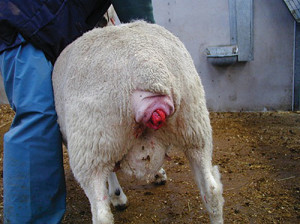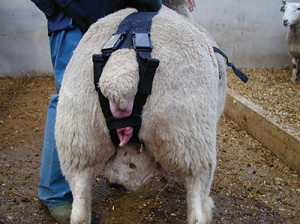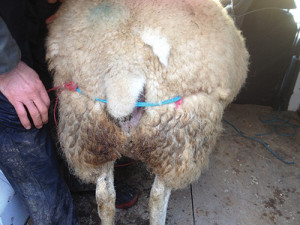Step-by-step guide to dealing with vaginal prolapse in sheep
Vaginal prolapses are a common problem for many flocks at lambing.
They can be caused because of a number of reasons; but generally ewes that are too fat, are carrying multiple lambs or have been fed a bulky diet in late pregnancy are most at risk.
Lameness, which causes increased lying times, can also be a risk factor.
 Victoria Fisher, Farm First Veterinary Services (part of XLVets)
Victoria Fisher, Farm First Veterinary Services (part of XLVets)This simple step-by-step guide written by a vet explains how to replace a prolapse and keep it in.
What is a vaginal prolapse?
Vaginal prolapses can be a common problem on many farms at lambing time.
A prolapse occurs when a ewe pushes her vagina out of her vulva.
It appears as a smooth, red mass, varying in size from a tennis ball to a melon.
 On examination the cervix can also be found as a small opening, as illustrated in the picture right.
On examination the cervix can also be found as a small opening, as illustrated in the picture right.
See also: How to prevent prolapse in overfit ewes
How can you identify the early signs of a prolapse?
Most ewes will prolapse in the last month of pregnancy. Early signs of a ewe prolapsing are similar to the signs of the early stages of labour and include:
- Isolation from the flock
- Stealing lambs
- Nesting behaviour/pawing at bedding
- Bleating
- Abdominal pressing or straining.
How can you treat a vaginal prolapse?
Vaginal prolapses should be replaced quickly to prevent further trauma and tears in the vagina.
If the prolapse remains out for a prolonged period of time the blood flow to the tissue can be reduced causing tissue death; the prolapse turns purple/black in colour and becomes dry, fragile and easy to damage.
Ideally, a ewe should be taken to a veterinary surgeon for treatment as they can administer an epidural (local anaesthetic injected into the spinal canal) which numbs the area around the vulva and reduces the ewe pushing, which eases replacement of the prolapse.
But you may wish to replace the prolapse yourself using the following steps.
1. Clean it
Wash the prolapse with plenty of clean, warm water containing a suitable antiseptic or disinfectant. Ensure contamination such as muck and straw are removed.
2. Check it
A thorough inspection of the prolapse should be made to check for any tears or signs the ewe is trying to lamb: waterbags or legs/tail may be felt passing through the cervix.
In either case seek veterinary advice. If intestines are visible through a tear, euthanasia is advisable.
3. Lubricate it
Cover with lubricating gel.
4. Replace it
Always handle the prolapse carefully to avoid damage. Try using either the flat of your hand or a fist.
With many prolapses the urinary bladder has actually flipped up inside the prolapse, blocking the neck of the bladder.
If you gently lift the prolapse up, towards the tail, this often allows the ewe to pass urine and the prolapse will reduce in size.
Then, using gentle pressure you can push the prolapse back into the ewe.
Often a ewe will continue to strain during replacement, but avoid pushing harder against her; instead just use enough pressure to stop the prolapse coming back out when she strains, then when she stops continue to replace it.
5. Keeping it in
 Once you have successfully replaced the prolapse, there are three ways to keep it in the ewe.
Once you have successfully replaced the prolapse, there are three ways to keep it in the ewe.
Harness (shown right): These are designed to apply pressure around the vulva and prevent the prolapse recurring.
These should be fitted correctly and checked regularly to ensure they do not cause sores.
Harnesses should be loosened or removed around lambing to allow the lambs to pass.
Spoon/T-piece/retainer (shown below, right): This is a T-shaped device that is inserted into the vagina and then secured to the ewe using string.
Always ensure the device is cleansed and disinfected prior to insertion.
 In most cases the ewe will be able to lamb past the spoon, but ideally it should be removed when lambing occurs.
In most cases the ewe will be able to lamb past the spoon, but ideally it should be removed when lambing occurs.
Buhner sutures (under local anaesthetic only): This is where sutures are placed into the vulval skin and pulled tight, so that only two fingers can pass through.
If these sutures are used they must be loosened at lambing otherwise the lambs may not pass, or the ewe will tear the sutures out causing severe damage to the area.
6. Inject
Affected ewes should be given a broad-spectrum antibiotic and a painkiller to help reduce infection.
7. Mark the ewe
Vaginal prolapses are highly repeatable, so these ewes should be marked permanently (marker spray or ear mark/tag) and should not be retained for breeding.
8. Prevention
There are several reasons why ewes may prolapse prior to lambing; these are outlined in the table below with suggestions for control.
Prolapse management tips |
|
|
Cause |
Control |
|
High body condition score |
Appropriate nutrition |
|
Carrying multiple lambs |
Scan ewes/appropriate nutrition |
|
Bulky diet |
Avoid a diet high in root crops in late pregnancy |
|
Lameness (increases lying down time) |
Five-point lameness control plan |
|
Lack of exercise |
Effective housing |
|
Low blood calcium |
Appropriate nutrition |
